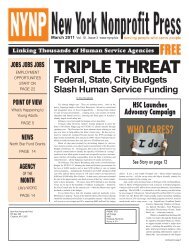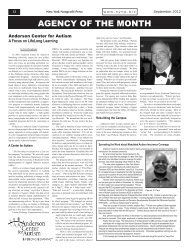New York Therapeutic Communities, Inc.: Still Stay'n Out after 30 ...
New York Therapeutic Communities, Inc.: Still Stay'n Out after 30 ...
New York Therapeutic Communities, Inc.: Still Stay'n Out after 30 ...
You also want an ePaper? Increase the reach of your titles
YUMPU automatically turns print PDFs into web optimized ePapers that Google loves.
July/August 07 <strong>New</strong> <strong>York</strong> Nonprofit Press www.nynp.biz 11<br />
AGENCY OUR HERO OF THE MONTH<br />
like Serendipity II meet<br />
the specific needs of<br />
women in ways which<br />
co-ed programs simply<br />
can’t, he explains.<br />
“It helps the ladies stay<br />
more focused,” says Migdalia Hernandez, a<br />
graduate of Serendipity I ten years ago who<br />
now works as a counselor at Serendipity II.<br />
“It is one less obstacle to deal with.”<br />
“When we had the women’s beds in<br />
the male residence before this opened they<br />
were always vacant. When we opened this<br />
program in 2001, we were full within three<br />
weeks, ” says Varma.<br />
Serendipity II is particularly attuned to<br />
the issues of residents, many of whom have<br />
co-occurring substance abuse and mental<br />
health disorders. “Probably 80-90% of the<br />
women who come here have some type of<br />
mental health issues and probably 50-60%<br />
are on serious medications,” says Varma.<br />
“We participated in a pilot project with OA-<br />
SAS to be designated as a co-occuring treathis<br />
car and which subway stop his staff would<br />
be coming to for night shifts at the residence.<br />
“I had never been personally threatened before,”<br />
says Williams.<br />
NYTC’s primary – if not sole – local supporter<br />
was State Senator Velmanette Montgomery,<br />
a former social worker, who had<br />
been won over through a visit by Stay’n <strong>Out</strong><br />
program graduate John David. Montgomery<br />
had known David, a Bed Stuy native, before<br />
he turned his life around. “She told me that if<br />
this program could work for John David, then<br />
we need it here,” says Williams. Montgomery<br />
braved a near revolt from her own constituency<br />
who threatened to punish her at the polls come<br />
reelection time.<br />
Once again, Williams worked to win over<br />
the community by addressing the issues they<br />
were concerned about. Residents feared the<br />
program would scare off a bank located next<br />
door - the only bank in an 18-square block<br />
area. Williams resolved that concern when he<br />
promised to move the agency’s account into<br />
the branch and open separate accounts for<br />
each of the 50 residents. He mustered program<br />
participants as volunteers for painting<br />
and maintenance at local senior and child care<br />
centers. Stay’n <strong>Out</strong> graduates began offering<br />
anti-drug, anti-crime programs at community<br />
schools. And, he created a Friends of Serendipity<br />
program. “If you were coming home at<br />
11:00 at night and were feeling nervous, call<br />
us,” he explains. “We’ll send over two strapping<br />
guys to meet you at the subway and walk<br />
you to your door.”<br />
<strong>New</strong> <strong>York</strong> <strong>Therapeutic</strong> <strong>Communities</strong>’ Stay’n <strong>Out</strong> program provides in-prison<br />
drug treatment for inmates nearing parole at the Arthur Kill Correctional<br />
Facility on Staten Island.<br />
signment in the program. In Phase<br />
II they are assessed for educational<br />
and vocational training. During<br />
Phase III, they begin attend training<br />
programs in the community and in<br />
Phase IV they find actual employment.<br />
Throughout, there are morning<br />
and evening groups, encounter<br />
sessions and lots of counseling.<br />
Residents typically stay nineto-12<br />
months as they complete the<br />
program. “I meet with clients once<br />
they move out for a minimum of six<br />
months, sometimes longer,” says<br />
Al Marcellino, Program Director at<br />
Serendipity I. “We have an <strong>after</strong>care<br />
group every Thursday. Usually seven<br />
to 15 men show up. Anyone can<br />
come back at any time. We are open<br />
24/7 so there is always a counselor<br />
on duty to talk to them.”<br />
In addition to inmates coming<br />
from the prison-based Stay’n <strong>Out</strong><br />
programs, Serendipity gets referrals<br />
from a variety of criminal justice sources, including<br />
drug courts. Serendipity often serves<br />
as an alternative to incarceration. “I got a<br />
second chance at life,” says Angel who was<br />
looking at an eight-to-25-year prison term on<br />
his most recent offense. “They gave me an<br />
opportunity to take a drug treatment program.<br />
I am going on a year clean; no drugs, I never<br />
had a dirty urine. I would rather be sober and<br />
broke than going to jail. I wish I would have<br />
known this a long time ago. I spent a lot of<br />
time in jail.” After nine months in the program,<br />
Angel is looking<br />
forward to finding a job<br />
and moving home to his<br />
youngest daughter and<br />
her mother. “They are<br />
there for me,” he says.<br />
Serendipity II<br />
Serendipity II, a<br />
block away, provides<br />
treatment for 40 women.<br />
“Generally, there is<br />
a shortage of women’s<br />
programs,” says Varma.<br />
Specialized programs<br />
Stay’n <strong>Out</strong> helps inmates make the transition back into society by linking them directly to community-based treatment<br />
programs, like NYTC’s own Serendipity I program in Bedford Stuyvesant.<br />
Before long, the facility had become an<br />
accepted part of the community – so much a<br />
part that when NYTC took over an abandoned<br />
OASAS facility to open a 40-bed Women’s<br />
program, Serendipity II – there was hardly a<br />
ripple.<br />
Today, Serendipity I treats 50 men as they<br />
work to turn their lives around. Alan Williams<br />
serves as a role model for success. “I was the<br />
first resident when it opened 17 years ago. I<br />
was the only resident. I spend the night here<br />
by myself,” he says. “Now I am back working<br />
as staff.”<br />
In a fairly typical TC model, residents<br />
progress through multi-phase program beginning<br />
with a <strong>30</strong>-day orientation period where<br />
they learn the community’s rules and procedures.<br />
In Phase I they are assigned a work asment<br />
site. Our staff received specialized<br />
training over a one-year period.”<br />
In the process, Serendipity II has made<br />
modifications to the traditional TC model.<br />
“We have had to evolve over time,” says<br />
Varma. “We have had to decrease the intensity<br />
of some of the activities. TCs are very<br />
much into strong behavioral encounters. It<br />
is something we all believe in very strongly<br />
but we have had to tone it down a notch.”<br />
Instead of the traditional “pull-ups” on negative<br />
behaviors, Serendipity II tries to use<br />
more “push-ups” – encouragement for positive<br />
behavior.<br />
“The mission doesn’t change, the methods<br />
do,” says Lisa Alexander, Program Director<br />
at Serendipity II. It is not just a mental<br />
health issue. “It is very crucial for women<br />
in treatment to get positive affirmation. We<br />
deal with a lot of women who have no selfesteem<br />
-- not low self-esteem, none.”<br />
The approach works. “I was on drugs<br />
for 15 years,” says Clarabelle who has been<br />
in the program for ten months. “I didn’t stop<br />
until I got here.” In addition to addressing<br />
her substance abuse problem, Serendipity II<br />
has helped Clarabelle get off the psychotropic<br />
medications which also limited her ability<br />
to function. “It took me three months to<br />
see I didn’t need them any more. I am stable<br />
and focus more. I see my future. This place<br />
has helped me a lot.”<br />
Probation<br />
Two years ago, NYTC broadened its<br />
services into a new segment of the criminal<br />
justice arena. It now operates two on-site<br />
drug treatment programs for the <strong>New</strong> <strong>York</strong><br />
City Department of Probation.<br />
“Each borough has a reporting center<br />
for approximately 1,000 clients who are at<br />
high risk of violating probation,” says Varma.<br />
“We provide on-site drug treatment for<br />
approximately 125 clients at each of these<br />
sites.” It is a one-stop service model. Clients<br />
come for drug treatment services on<br />
site three times a week for two groups and<br />
one individual counseling session. Clients<br />
simultaneously report to their probation officer<br />
and get drug tested.<br />
“We find it to be very successful,” says<br />
Varma. “Probation finds that there is better<br />
attendance in our program than if clients go<br />
to substance abuse treatment off site. They<br />
also stay in the program longer.” The results<br />
are particularly favorable given the fact that<br />
these clients were “one step from Riker’s”<br />
when they first come in.<br />
NYTC opened its first program in<br />
Brooklyn in 2005 and a second site in<br />
Queens last year. Now it is in discussions<br />
with Probation about the possibility of opening<br />
additional programs in Manhattan and<br />
the Bronx.<br />
Thirty Years Later<br />
Times have changed since Ron Williams<br />
first struggled to win acceptance for a treatment<br />
program inside prison walls. “From<br />
1977 to today, attitudes have changed exponentially,”<br />
says Varma. “DOCS folks are very<br />
very cooperative and positive.”<br />
“I have very high hopes system wide,”<br />
says Williams, citing the recent appointment<br />
of Brian Fisher as Commissioner at DOCS.<br />
“I have known him for years. He was the<br />
warden at Sing Sing, one of the only prisons<br />
in the downstate area to have a college program.<br />
In order for it to be there, he had to<br />
fight for it.”<br />
<strong>Still</strong>, there is much work to do. Today,<br />
NYTC’s Stay’n <strong>Out</strong> programs at Arthur Kill<br />
and Bayview are the only privately run drug<br />
treatment programs within the DOCS system.<br />
(DOCS operates its own drug treatment programs<br />
at several facilities.)<br />
Williams also believes there is a growing<br />
need for additional programs serving<br />
women coming out of the correctional system.<br />
“While the general prison population in<br />
<strong>New</strong> <strong>York</strong> State is decreasing, the number of<br />
women who are incarcerated is rising,” says<br />
Williams. “If we are going to break the cycle<br />
of crime and incarceration, we must provide<br />
additional services for these women. These<br />
are the hands that rock the cradle.” Williams<br />
is particularly hopeful that NYTC will be able<br />
to develop day programming to serve the specific<br />
needs of women with children.<br />
For information about the programs run<br />
by <strong>New</strong> <strong>York</strong> <strong>Therapeutic</strong> <strong>Communities</strong>, <strong>Inc</strong>.<br />
visit www.staynout.org.











